Sarah Sundin's Blog, page 335
July 24, 2015
Through Waters Deep – Tour of Boston, Part 2
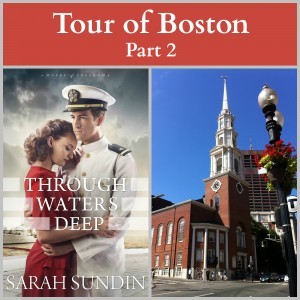 The city of Boston is fascinating—chockfull of history and color. While best known for its key role in the American Revolution, the city also played a role in World War II, with busy shipyards and naval bases—and more! The city’s reputation for revolutionary foment seemed a great backdrop for Through Waters Deep, set in the tumult of 1941, as isolationists and interventionists argued the correct course for the nation’s future, and as rumors of sabotage and espionage ran rampant.
The city of Boston is fascinating—chockfull of history and color. While best known for its key role in the American Revolution, the city also played a role in World War II, with busy shipyards and naval bases—and more! The city’s reputation for revolutionary foment seemed a great backdrop for Through Waters Deep, set in the tumult of 1941, as isolationists and interventionists argued the correct course for the nation’s future, and as rumors of sabotage and espionage ran rampant.
To enter the giveaway for Through Waters Deep, see the information at the end of the post.
I’ve been blessed to visit Boston a number of times. In July 2014, I made a research trip and took lots of pictures to help me visualize the story. We’ll follow the Freedom Trail, established in the 1950s to connect Boston’s multiple historical sites. Earlier we explored Boston Common and the Public Garden. Today we visit Park Street Church. When writing Through Waters Deep, I chose Park Street as the church my hero and heroine would attend, due to its long history in Boston and its role in the birth of the evangelical movement in the early 1940s. In July 2014, I was able to attend a Sunday service at Park Street and take pictures (before the service started).
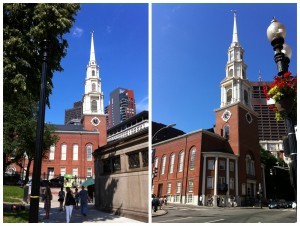
In 1809, Park Street Church was founded to support traditional Christian teachings in a time when Unitarianism was growing in strength in New England. Taking a strong stand for biblical teaching, the founders faced much opposition. From the beginning, the church believed in the cornerstones of missions, evangelism, Christian education, involvement in social issues, and biblical teaching. To this day, the church keeps the same Statement of Faith adopted in 1809.
Brimstone Corner: Park Street Church, Boston (Moody Press) presents the history of this church up to 1968, showing cycles of stagnation, intense external opposition, and stirring revival—while refusing to budge from the fundamentals—an uplifting account of how God can use even one small church to have an impact on the world.
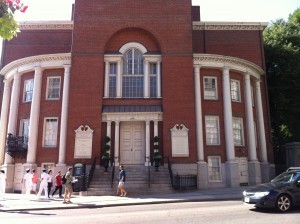
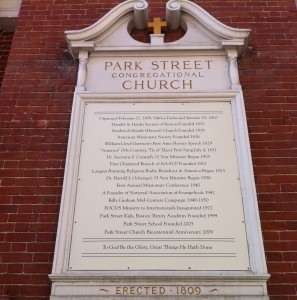
Park Street Church has a long string of historical firsts. In 1819, Park Street sent the first team of missionaries to the Sandwich Islands (Hawaii). In 1829, William Lloyd Garrison, founder of the American Anti-Slavery Society, gave his first abolitionist speech at Park Street. And the patriotic song America (My Country, ‘Tis of Thee) was first performed on July 4, 1831 at Park Street.
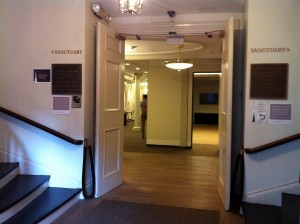
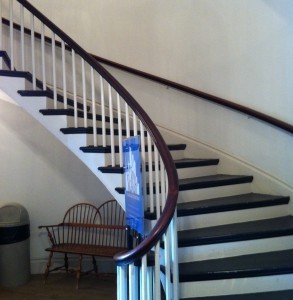
From 1936-1969, Dr. Harold J. Ockenga served as pastor of Park Street. In the first part of the twentieth century, the rise of secularism in mainline churches led to the rise of fundamentalism, with its call to separate from the culture. In response, Ockenga and others gave rise to the modern evangelical movement, which kept fundamentalism’s stand for theological truth, while rejecting its trend toward isolation from culture. In 1942, the National Association of Evangelicals was formed, with Ockenga as president.
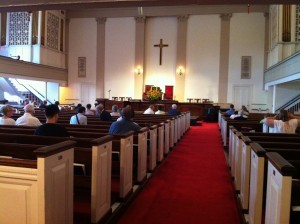
On May 30, 1943, Dr. Ockenga began an outdoor evangelical ministry on Boston Common. At the first service, 3500 servicemen and civilians enjoyed music and teaching, and many came to Christ. The services continued through that summer and the next, until opponents caused the city to cancel the permit. Not to be silenced, Ockenga continued conducting the services from the church steps, and later from the “Mayflower Pulpit” on the side of the church—across the street from Boston Common.
For Lent in 1944, the congregation of Park Street Church decided to forego one meal a week and to donate the money saved to a new War Relief Fund, designed to help the churches of Europe rebuild after the war. The idea swept the nation to other churches, and on Easter morning $600,000 was collected. In 1950, the War Relief Commission was renamed World Relief, which remains active to this day. In another landmark for Park Street, Billy Graham began his first transcontinental crusade at the church in 1949.
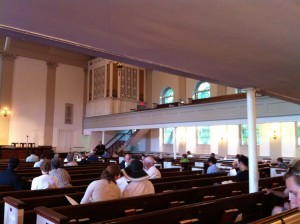
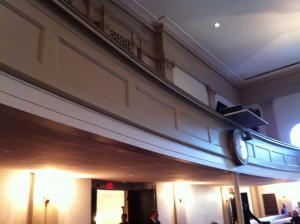
Sources:
Park Street Church website: http://www.parkstreet.org/
Englizian, H. Crosby. Brimstone Corner: Part Street Church, Boston. Chicago: Moody Press, 1968.
Wikipedia: https://en.wikipedia.org/wiki/Park_Street_Church
Giveaway
This week I’m giving away THREE copies of Through Waters Deep! To enter, leave a comment below (US & Canada only please), on the video post, or on any of the Tour of Boston posts (Part 1, Part 3), which will show the sites featured in the novel. You can earn a maximum of four entries by leaving a comment on each of the four posts. If you can’t leave a comment, please send me an email to enter. Giveaway ends Monday, July 27, 2015 at midnight, Pacific Time. I’ll announce the winner here on Wednesday, July 29, 2015.
Today in World War II History—July 24, 1940 & 1945
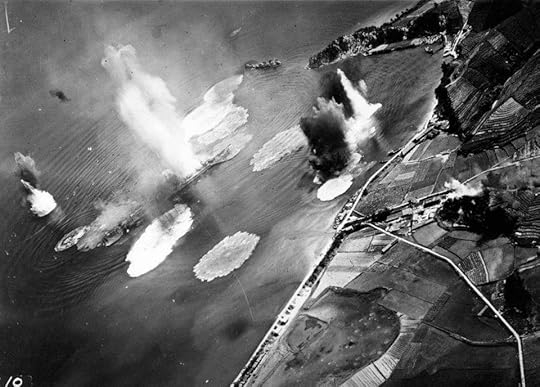
Japanese cruiser Tone under air attack near Kure, Japan, 24 Jul 1945; photo taken by USS Shangri-La aircraft. (US National Archives)
75 Years Ago—July 24, 1940: Off Brittany, German torpedo boat S-27 sinks French liner Meknes which is repatriating French soldiers from Britain to Vichy France (416/1277 killed).
70 Years Ago—July 24, 1945: US carriers annihilate Japanese fleet at Kure, sinking battleship-carrier Hyuga and heavy cruiser Tone.
July 23, 2015
Today in World War II History—July 23, 1940 & 1945
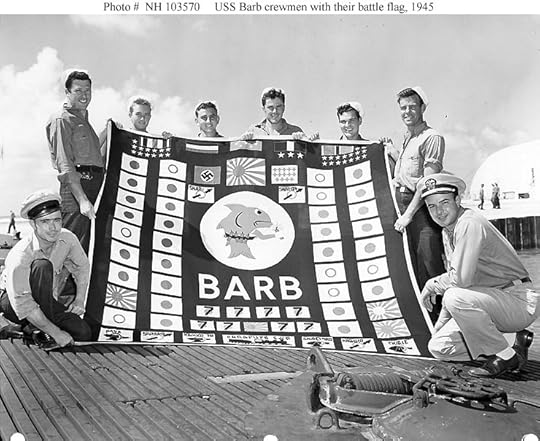
Members of USS Barb’s demolition squad, Pearl Harbor, August 1945. These men went ashore at Karafuto, Japan, and planted an explosive charge that wrecked a train. This raid is represented by the train symbol in the middle bottom of the battle flag. (US Navy photo)
75 Years Ago—July 23, 1940: British Home Guard is officially created (formerly Local Defence Volunteers) with 1.3 million civilian volunteers to protect the home front.
70 Years Ago—July 23, 1945: Marshal Henri Pétain goes on trial in Paris for collaborating with Nazis; his death sentence will be commuted due to age. Submarine USS Barb lands raiders on Karafuto (between Japan & mainland Asia), who blow up a train and escape.
July 22, 2015
Through Waters Deep – Tour of Boston, Part 1

The city of Boston is fascinating—chockfull of history and color. While best known for its key role in the American Revolution, the city also played a role in World War II, with busy shipyards and naval bases—and more! The city’s reputation for revolutionary foment seemed a great backdrop for Through Waters Deep, set in the tumult of 1941, as isolationists and interventionists argued the correct course for the nation’s future, and as rumors of sabotage and espionage ran rampant.
To enter the giveaway for Through Waters Deep, see the information at the end of the post.
I’ve been blessed to visit Boston a number of times. In July 2014, I made a research trip and took lots of pictures to help me visualize the story. We’ll follow the Freedom Trail, established in the 1950s to connect Boston’s multiple historical sites.
Public Garden
First stop (not officially on the Freedom Trail)…Boston’s Public Garden, filled with beautiful botanical specimens and dominated by a large and picturesque lagoon. The lagoon is home to the famous Swan Boats from April to September, which you can watch from the little pedestrian suspension bridge. In the 1940s, ice-skaters criss-crossed the frozen waters! The year 1941 marks the publication of Make Way for Ducklings by Robert McCloskey, set in the Public Garden. Today a statue of the ducklings delights visitors. For more serious-minded tourists, George Washington is also honored with a grand statue.
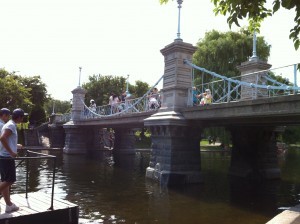
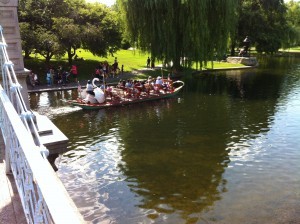
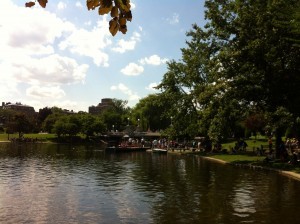
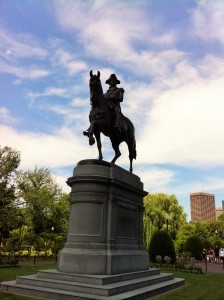
Boston Common
Next stop…Boston Common, the oldest public park in the world, dating from 1634. Throughout history it has served as grazing land for livestock, a location for hangings, training grounds for British troops, and a place of oratory and celebrations. The Parkman Bandstand has been used for music, theater, and speakers. Today the Frog Pond is used for ice-skating in the winter and wading in the summer.
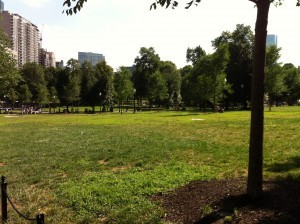

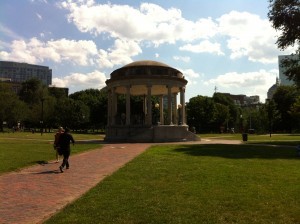
Located on Boston Common, Park Street and Boylston Stations are the first subway stations in America, dating from 1897, three years before New York’s subway opened. At the northeast corner of the Common stands the Robert Gould Shaw Memorial, erected in 1897 to honor the 54th Regiment Massachusetts Volunteer Infantry, the African-American unit that served with distinction in the Civil War. Across Beacon Street from the Shaw Memorial is the Massachusetts State House, the capitol of the Commonwealth of Massachusetts. Designed by architect Charles Bulfinch and completed in 1798, the dome was covered in copper by Paul Revere in 1802, then in gold leaf in 1874. After Pearl Harbor, the dome was painted black as an air raid precaution!
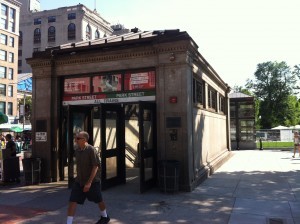
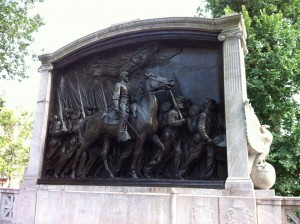
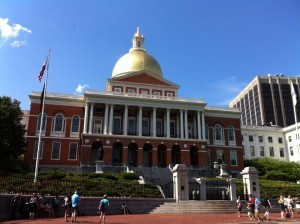
Sources:
Freedom Trail Foundation: http://www.thefreedomtrail.org/
National Historical Park, Massachusetts: http://www.nps.gov/bost/planyourvisit/index.htm
Wikipedia: http://en.wikipedia.org/wiki/Freedom_Trail
Giveaway
This week I’m giving away THREE copies of Through Waters Deep! To enter, leave a comment below (US & Canada only please), the video post, or any of the upcoming Tour of Boston posts (Part 2, Part 3), which will show the sites featured in the novel. You can earn a maximum of four entries by leaving a comment on each of the four posts. If you can’t leave a comment, please send me an email to enter. Giveaway ends Monday, July 27, 2015 at midnight, Pacific Time. I’ll announce the winner here on Wednesday, July 29, 2015.
Today in World War II History—July 22, 1940 & 1945
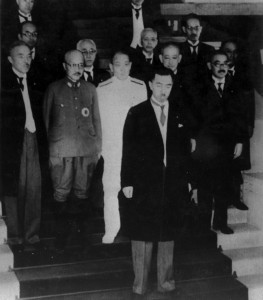
Japanese Prime Minister Fumimaro Konoe and his second cabinet at the Kantei, Tokyo, Japan, 22 Jul 1940
75 Years Ago—July 22, 1940: Britain officially rejects Hitler’s “peace offer.” Britain establishes Special Operations Executive (SOE) under Hugh Dalton to support resistance groups in Nazi-occupied Europe. New Japanese cabinet formed with Prince Fumimaro Konoe as Prime Minister.
70 Years Ago—July 22, 1945: First US troops transferred from Europe arrive in the Philippines.
July 21, 2015
Today in World War II History—July 21, 1940 & 1945
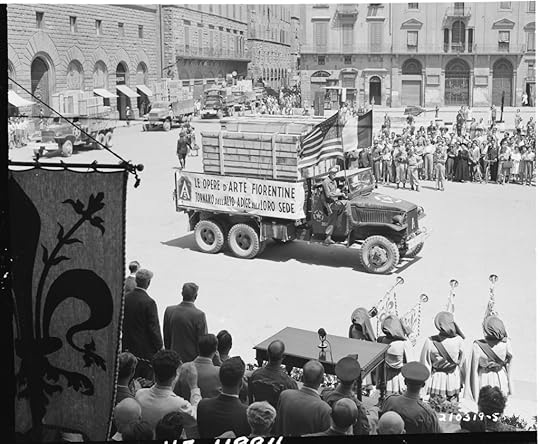
American trucks returning part of US$500 million worth of Florentine artwork looted by Germans, Piazzo Dei Signoria, Florence, Italy, 21 Jul 1945 (US National Archives)
75 Years Ago—July 21, 1940: Romania forced by Germany to give Dobruja province to Bulgaria.
70 Years Ago—July 21, 1945: Six truckloads of art stolen by the Nazis is returned to Florence, Italy. Detroit Tigers and Philadelphia Athletics play a 24-inning game, ending in a 1-1 tie.
July 20, 2015
Through Waters Deep – Video, Launch Party, and Giveaway!
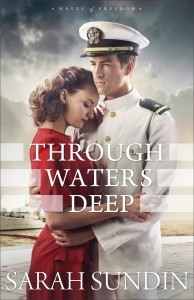 Through Waters Deep is coming soon! The first book in the Waves of Freedom series officially releases on August 4, 2015, but it’s already available at some locations.
Through Waters Deep is coming soon! The first book in the Waves of Freedom series officially releases on August 4, 2015, but it’s already available at some locations.
This week I’m giving away THREE copies of Through Waters Deep! To enter, leave a comment below (US & Canada only please), and/or on any of the upcoming Tour of Boston posts, which will show the sites featured in the novel. You can earn a maximum of four entries by leaving a comment on each of the four posts. If you can’t leave a comment, please send me an email to enter. Giveaway ends Monday, July 27, 2015 at midnight, Pacific Time. I’ll announce the winner here on Wednesday, July 29, 2015.
Video
I’m thrilled with the book cover Revell created, with photography by Brandon Hill Photos. Here’s a fun behind-the-scenes video from the photo shoot! So much care was put into the details – the right look for the models, “Mary’s” dress, hair, and makeup, and “Jim’s” uniform.
Enjoy!
Launch Party
 If the video made you feel like dancing, come join us at the launch party for Through Waters Deep! On August 8, 2015, we’ll be launching the novel at Barnes & Noble in Antioch, CA at 7 pm. My literary agent, Rachel Kent, will be teaching swing dance for anyone willing. We’ll have light refreshments, giveaways, a reading, and a book signing. 1940s attire is optional – but welcome!
If the video made you feel like dancing, come join us at the launch party for Through Waters Deep! On August 8, 2015, we’ll be launching the novel at Barnes & Noble in Antioch, CA at 7 pm. My literary agent, Rachel Kent, will be teaching swing dance for anyone willing. We’ll have light refreshments, giveaways, a reading, and a book signing. 1940s attire is optional – but welcome!
Today in World War II History—July 20, 1940 & 1945
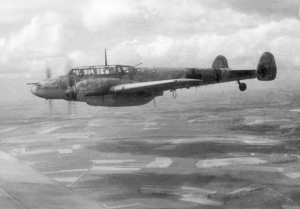
Messerschmitt Me 110 night-fighter (Nachtjagdgeschwader 4), 1943. (German Federal Archive: Bild 101I-377-2801-013)
75 Years Ago—July 20, 1940: Luftwaffe night-fighters (Me 110s) first shoot down a British plane. Billboard first publishes singles records chart—“I’ll Never Smile Again” is at the top.
70 Years Ago—July 20, 1945: US Congress ratifies Bretton Woods Monetary Agreement.
July 19, 2015
Today in World War II History—July 19, 1940 & 1945
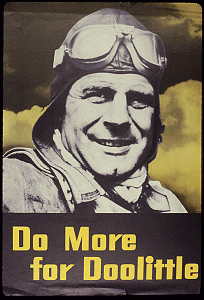 75 Years Ago—July 19, 1940: Germany holds a victory parade in Berlin. Hitler appoints 19 field marshals. Hitler orders Britain to settle for peace; BBC replies unofficially in the negative within 1 hour.
75 Years Ago—July 19, 1940: Germany holds a victory parade in Berlin. Hitler appoints 19 field marshals. Hitler orders Britain to settle for peace; BBC replies unofficially in the negative within 1 hour.
70 Years Ago—July 19, 1945: Lt. Gen. James Doolittle establishes the US Eighth Air Force on Okinawa, having transferred from England.
July 18, 2015
Today in World War II History—July 18, 1940 & 1945
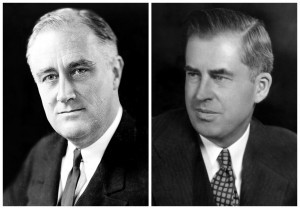
Franklin D. Roosevelt, 1933 (US Library of Congress) and Henry A. Wallace (US Department of Agriculture)
75 Years Ago—July 18, 1940: Royal Air Force sinks German invasion barges in Rotterdam, Holland and St. Omer, France. At Democratic convention in Chicago, Franklin Roosevelt is nominated for third term as president with VP candidate Henry A. Wallace.
70 Years Ago—July 18, 1945: US Third Fleet carrier aircraft sink Japan’s last big battleship, the Nagato, at Yokosuka naval base near Tokyo. At Bedford Naval Magazine in Nova Scotia, explosions occur for 24 hours, but only one person is killed.



